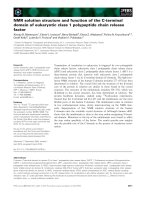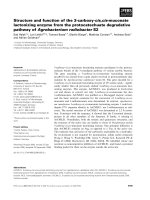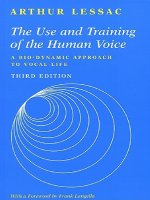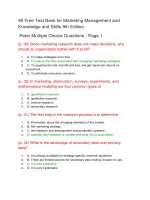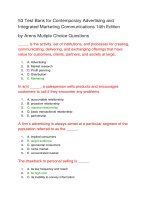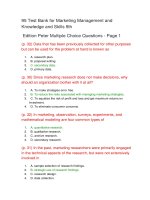Test bank for memmlers structure and function of the human body 9th edition
Bạn đang xem bản rút gọn của tài liệu. Xem và tải ngay bản đầy đủ của tài liệu tại đây (136.65 KB, 18 trang )
Test Bank for Memmlers Structure and Function of the Human
Body 9th Edition
The breakdown of complex glycogen molecules into simple glucose molecules
is most accurately described as a(n)
1. A) anabolic reaction
2. B) metabolic reaction
3. C) catabolic reaction
4. D) homeostatic reaction
Which of the following examples demonstrates the principle of positive
feedback?
1. A) A decrease in blood sugar stimulates the release of a hormone that
increases blood sugar.
2. B) A decrease in room temperature activates a thermostat, which increases
heat output by a furnace.
3. C) A rise in blood calcium levels stimulates the release of a hormone that
lowers blood calcium levels.
4. D) A rise in estrogen levels stimulates the production of a hormone that
stimulates estrogen production.
Which of the following examples does NOT demonstrate the principle of
homeostasis?
1. A) A rise in plasma sodium stimulates the release of a hormone that increases
sodium loss in the urine.
2. B) An increase in plasma volume increases urination.
3. C) The activation of a clotting factor stimulates the production of the enzyme
that activates the clotting factor.
4. D) An increase in body temperature induces sweating, which reduces body
temperature.
A term that means farther from the midline of the body is
1. A) sagittal
2. B) lateral
3. C) distal
4. D) transverse
A term that describes the position of the stomach with respect to the lungs
is
1. A) medial
2. B) anterior
3. C) dorsal
4. D) inferior
A term that describes the position of the hypogastric region of the abdomen
with respect to the iliac region is:
1. A) medial
2. B) anterior
3. C) lateral
4. D) dorsal
The term that best describes the position of the elbow with respect to the
hand is
1. A) medial
2. B) anterior
3. C) proximal
4. D) inferior
A directional term that means nearer to the head is
1. A) caudal
2. B) inferior
3. C) lateral
4. D) cranial
A plane that divides the body into superior and inferior parts is the
1. A) sagittal plane
2. B) transverse plane
3. C) frontal plane
4. D) coronal plane
A plane that divides the body into anterior and posterior parts is the
1. A) sagittal plane
2. B) proximal plane
3. C) frontal plane
4. D) midsagittal plane
The dorsal body cavity contains the
1. A) spinal cord and lungs
2. B) brain and spinal cord
3. C) heart and kidney
4. D) brain and reproductive organs
Which of the following organs is NOT in the abdominopelvic cavity?
1. A) small intestine
2. B) stomach
3. C) lung
4. D) liver
The urinary bladder is located in the
1. A) thoracic cavity
2. B) spinal cavity
3. C) dorsal cavity
4. D) pelvic cavity
The most inferior medial region of the abdomen is the
1. A) epigastric region
2. B) inguinal region
3. C) hypogastric region
4. D) umbilical region
The iliac region of the abdomen is also called the
1. A) inguinal region
2. B) right upper quadrant
3. C) hypogastric region
4. D) left lower quadrant
The number of milliliters (mL) in a liter is
1. A) 2.5
2. B) 1,000,000
3. C) 1000
4. D) 100
The basic unit of weight in the metric system is the
1. A) pound
2. B) meter
3. C) gram
4. D) inch
The volume in U.S. measurements that is closest to a liter is the
1. A) quart
2. B) ounce
3. C) yard
4. D) pint
250 milligrams is equivalent to how many grams?
1. A) 0.25
2. B) 2.5
3. C) 25
4. D) 250
125 centimeters is equivalent to how many millimeters?
1. A) 1.25
2. B) 12.5
3. C) 1250
4. D) 12,500
The metric prefix that means 1000 is:
1. A) kilo
2. B) micro
3. C) milli
4. D) centi
The term homeo is best defined as
1. A) same
2. B) different
3. C) increased
4. D) decreased
A specialized group of cells make up a ________.
The system that takes in oxygen and expels carbon dioxide is the _______
system.
The skin and associated structures are called the _____________ system.
The system that includes the spinal cord is the ___________ system.
The term _________________ refers to all of the catabolic and anabolic
reactions that go on within the body.
The energy-storing compound found in all cells is ________.
Fluid within the cells is called ____________________ fluid.
Blood and lymph are examples of ___________________ fluid.
The term describing a state of internal balance is ________________.
A term that means farther from the origin of a structure is ______________.
A plane that divides the body into left and right parts is the ______________
plane.
The frontal plane is also called the _____________ plane.
The muscle separating the thoracic cavity from the abdominal cavity is the
________.
The basic unit of volume in the metric system is the ________.
The temperature scale used for scientific measurement is the ________.
The suffix –logy means ______________.
The study of how the body functions is
•
A) physiology
•
B) anatomy
•
C) physics
•
D) metabolism
The study of body structure is called
•
A) physiology
•
B) anatomy
•
C) astronomy
•
D) metabolism
Which of the following would be the most suitable field of study for an
anatomist?
•
A) the structure of the stomach
•
B) the mechanism of protein digestion
•
C) the stars
•
D) anabolic reactions
Dr. A is interested in the structure of the inner ear. The field of study best
suited to her interests is
•
A) physiology
•
B) anatomy
•
C) pathology
•
D) wind-surfing
There are numerous levels of organization in the body. The correct order from
simplest to most complex is
•
A) organ, tissue, cell, organism, system
•
B) cell, tissue, organ, system, organism
•
C) system, cell, organ, organism, tissue
•
D) cell, system, tissue, organ, organism
The system that transports blood to and from the cells is the
•
A) integumentary system
•
B) skeletal system
•
C) respiratory system
•
D) circulatory system
The system comprised of the bones and the joints is the
•
A) skeletal system
•
B) nervous system
•
C) immune system
•
D) muscular system
A term for all the reactions that sustain life is
•
A) anabolism
•
B) catabolism
•
C) metabolism
•
D) cannibalism
A reaction in which simple compounds are assembled into more complex
compounds is most accurately described as a(n)
•
A) anabolic reaction
•
B) metabolic reaction
•
C) catabolic reaction
•
D) homeostatic reaction
Answer Given
tissue
Answer Given
respiratory
Answer Given
integumentary
Answer Given
nervous
Answer Given
metabolism
Answer Given
ATP
Answer Given
intracellular
Answer Given
extracellular
Answer Given
homeostasis
Answer Given
distal
Answer Given
sagittal
Answer Given
coronal
Answer Given
diaphragm
Answer Given
liter
Answer Given
Celsius scale
Answer Given
study of
The study of how the body functions is
1. A) physiology
2. B) anatomy
3. C) physics
4. D) metabolism
study of
The study of body structure is called
1. A) physiology
2. B) anatomy
3. C) astronomy
4. D) metabolism
study of
Which of the following would be the most suitable field of study for an
anatomist?
1. A) the structure of the stomach
2. B) the mechanism of protein digestion
3. C) the stars
4. D) anabolic reactions
study of
Dr. A is interested in the structure of the inner ear. The field of study best
suited to her interests is
1. A) physiology
2. B) anatomy
3. C) pathology
4. D) wind-surfing
study of
There are numerous levels of organization in the body. The correct order from
simplest to most complex is
1. A) organ, tissue, cell, organism, system
2. B) cell, tissue, organ, system, organism
3. C) system, cell, organ, organism, tissue
4. D) cell, system, tissue, organ, organism
study of
The system that transports blood to and from the cells is the
1. A) integumentary system
2. B) skeletal system
3. C) respiratory system
4. D) circulatory system
study of
The system comprised of the bones and the joints is the
1. A) skeletal system
2. B) nervous system
3. C) immune system
4. D) muscular system
study of
A term for all the reactions that sustain life is
1. A) anabolism
2. B) catabolism
3. C) metabolism
4. D) cannibalism
study of
A reaction in which simple compounds are assembled into more complex
compounds is most accurately described as a(n)
1. A) anabolic reaction
2. B) metabolic reaction
3. C) catabolic reaction
4. D) homeostatic reaction
study of

